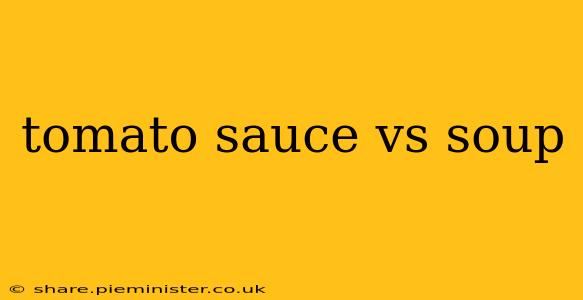Tomato sauce and tomato soup, while both featuring tomatoes as their star ingredient, are distinct culinary creations with significant differences in texture, flavor profile, and intended use. This comprehensive guide delves into the nuances separating these two popular tomato-based dishes, answering common questions and providing a clearer understanding of their unique characteristics.
What is the Difference Between Tomato Sauce and Tomato Soup?
The primary difference lies in their consistency and intended purpose. Tomato sauce is typically thicker, richer, and more intensely flavored, acting as a base for other dishes. It's designed to coat pasta, pizza, or meat, adding depth and complexity to the overall flavor profile. Tomato soup, on the other hand, is thinner, often creamier, and less intensely flavored, intended to be enjoyed as a standalone meal or appetizer. It's designed for sipping and savoring, offering a comforting and often simple taste. The key differentiator is the intended consumption—sauce enhances other foods; soup is enjoyed on its own.
Is Tomato Sauce Thicker Than Tomato Soup?
Yes, tomato sauce is considerably thicker than tomato soup. This difference is intentional and directly reflects their culinary purpose. Tomato sauce achieves its thickness through longer cooking times, allowing the water to evaporate and the tomatoes to reduce. Ingredients like tomato paste and sometimes even a roux are added to further thicken the sauce. Tomato soup, however, often maintains a thinner consistency by adding more liquid (broth, water, or cream) and minimizing cooking time.
What Makes Tomato Soup Different From Tomato Sauce?
Beyond thickness, several factors distinguish tomato soup from tomato sauce:
-
Flavor Profile: Tomato sauce often prioritizes a bold, tangy, and sometimes slightly acidic flavor. Herbs, spices, and other aromatics are frequently incorporated to create a complex flavor profile. Tomato soup, in contrast, often focuses on a smoother, more balanced flavor. It might incorporate sweeteners (like sugar or honey) to soften the acidity of the tomatoes and often features creamy additions like milk or cream.
-
Ingredients: Tomato sauce typically utilizes simple ingredients: tomatoes (fresh, canned, or paste), garlic, onions, herbs, and spices. Tomato soup may incorporate a wider range of ingredients, including cream, milk, broth, vegetables (like carrots or celery), and even noodles or rice.
-
Serving Method: Tomato sauce is rarely consumed on its own. It's almost always used as a condiment or ingredient in other dishes. Tomato soup is typically served in a bowl as a standalone dish, either hot or cold.
Can You Use Tomato Sauce as Soup?
While you can technically use tomato sauce as a base for a soup by thinning it with broth or water, it’s unlikely to deliver the same taste experience as a true tomato soup. The intense flavors of a reduced tomato sauce might overpower other ingredients and lack the balance that is often sought in a soup. Adding cream or other common soup ingredients would alter the character of the sauce, effectively creating something new rather than simply thinning it.
Can You Use Tomato Soup as Sauce?
Using tomato soup as a sauce is generally not recommended. Its thin consistency won't coat pasta or meat effectively, and its often milder flavor profile might get lost among other robust ingredients. The added cream or milk in many tomato soup recipes would also create an undesirable texture and flavor when used as a sauce for pasta or other savory dishes.
Conclusion: Tomato Sauce vs. Tomato Soup – A Culinary Distinction
Ultimately, tomato sauce and tomato soup represent distinct culinary entities with different characteristics, culinary applications, and intended uses. Understanding these differences allows you to appreciate the unique qualities of each and select the most appropriate option for any given recipe or culinary occasion. Both offer delicious and versatile culinary options, showcasing the versatility of the humble tomato.
